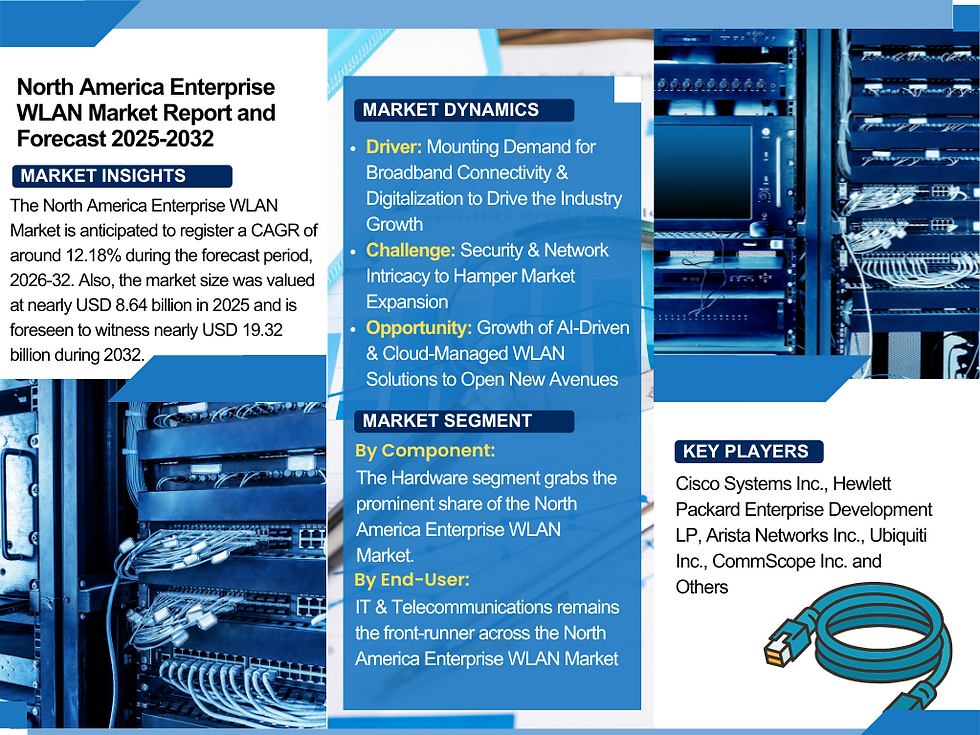North America Enterprise WLAN Market Insights and Outlook 2026–2032
- Davis Johnson
- Aug 22
- 3 min read

The North America Enterprise WLAN (Wireless Local Area Network) market is experiencing robust growth, driven by increasing digital transformation initiatives, the widespread adoption of mobile and IoT devices, and the rising demand for cloud-managed network solutions. As enterprises across sectors seek secure, scalable, and high-performance wireless connectivity, the market is poised for sustained expansion in the years ahead.
Market Overview
The North America Enterprise WLAN market is projected to grow from nearly USD 8.64 billion in 2025 to USD 19.32 billion by 2032, reflecting a compound annual growth rate (CAGR) of around 12.18%. This growth is underpinned by rapid technological advancements, including the deployment of Wi-Fi 6 and Wi-Fi 7, the adoption of AI-driven network management platforms, and the shift toward cloud-based WLAN architectures.
As enterprises embrace hybrid work models and digital-first operations, the WLAN ecosystem has become a critical enabler of productivity, mobility, and customer engagement.
Market Drivers
1. Digital Transformation Across IndustriesOrganizations in sectors such as healthcare, retail, BFSI, and manufacturing are increasingly relying on WLAN solutions to enable mobility, cloud connectivity, and remote access. This is creating significant demand for enterprise-grade wireless solutions.
2. Proliferation of IoT and BYOD TrendsThe rise of Internet of Things (IoT) applications and Bring Your Own Device (BYOD) policies is amplifying network traffic. Enterprises are investing in scalable WLAN systems that can manage dense device environments while maintaining security and performance.
3. Adoption of Wi-Fi 6 and Wi-Fi 7The rollout of next-generation wireless standards is transforming enterprise connectivity by delivering higher speeds, lower latency, and better support for multiple devices. Wi-Fi 7, in particular, is expected to drive upgrades across campuses, data centers, and distributed workplaces.
4. Shift to Cloud-Managed WLANCloud-based WLAN systems are gaining traction as they provide centralized visibility, simplified management, and enhanced scalability. These solutions are increasingly being adopted by SMEs and large enterprises alike.
Market Challenges
Despite its strong outlook, the market faces certain challenges:
· Rising Cybersecurity Threats: With more devices connecting to enterprise networks, the risk of breaches and attacks has intensified, requiring continuous investment in advanced security protocols.
· High Initial Costs: Deployment of advanced WLAN infrastructure, particularly for large campuses or multi-site enterprises, requires significant upfront investment.
· Complex Integration: Integrating WLAN with legacy IT systems and ensuring seamless interoperability can be a hurdle for enterprises undergoing digital transformation.
Segmental Analysis
1. By Component
o Hardware: Access points, controllers, and routers dominate the market, with demand fueled by the expansion of high-speed networks.
o Software and Services: Cloud management platforms, AI-driven analytics, and managed services are witnessing rapid adoption, as enterprises prioritize automation and efficiency.
2. By End User
o Healthcare: Hospitals and clinics are deploying enterprise WLAN to support telemedicine, connected medical devices, and patient monitoring systems.
o Education: The rapid adoption of e-learning platforms and connected campuses has created strong demand for high-performance WLAN infrastructure in schools and universities.
Competitive Landscape
The North America Enterprise WLAN market is moderately consolidated, with global and regional players competing through technological innovation, partnerships, and product launches. Key companies operating in the region include Cisco Systems, Aruba Networks (HPE), Extreme Networks, Juniper Networks, CommScope (Ruckus), and Fortinet.
These firms are focusing on developing Wi-Fi 6/6E and Wi-Fi 7 solutions, enhancing cloud-based management platforms, and integrating AI/ML-driven security features to strengthen their market position. Strategic acquisitions and collaborations are also shaping the competitive dynamics of the industry.
Regulatory and Policy Landscape
Government initiatives to expand broadband access, improve digital infrastructure, and enforce cybersecurity compliance are playing a pivotal role in market growth. Regulations related to data privacy, spectrum allocation, and network security standards influence enterprise WLAN deployments, particularly in sectors like healthcare and BFSI where data protection is critical.
Future Outlook
Looking ahead, the North America Enterprise WLAN market will continue to evolve in line with digital business priorities. The combination of cloud networking, Wi-Fi 7 adoption, edge computing, and AI-driven automation is set to redefine enterprise connectivity strategies. As organizations accelerate their investments in next-generation wireless infrastructure, vendors that deliver secure, scalable, and intelligent WLAN solutions will remain at the forefront of growth.







Comments